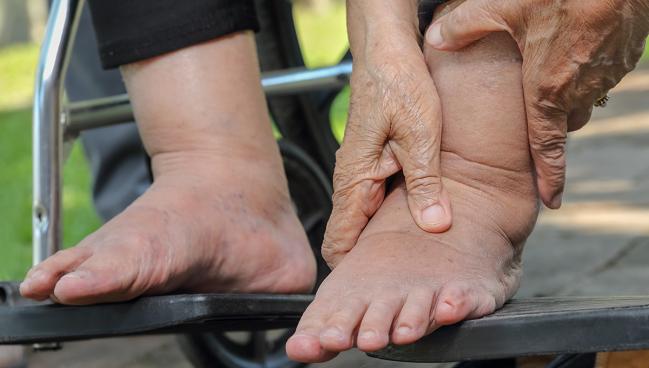ENACT-HF: Natriuresis-Guided Diuretic Protocol Beats Usual Care
The small, pragmatic study, not powered for hard endpoints, does validate ESC recommendations and should prompt change.

PRAGUE, Czechia—Current European Society of Cardiology (ESC) heart failure guidelines stipulate that a urinary sodium-guided approach is best for dosing diuretics in acute congestion, but many centers have continued to stick with their own protocols. Now a new study makes it clear: the ESC’s stricter protocol, using a higher starting dose and an earlier check-in on sodium levels, leads to significantly better natriuresis within the first day as well as better natriuresis and diuresis after 2 days.
Moreover, said Jeroen Dauw, MD (AZ Sint-Lucas, Ghent, Belgium), who presented the ENACT-HF study at the ESC Heart Failure Congress 2023 earlier this week, “The protocol was safe and feasible in a wide variety of healthcare settings” and led to significantly shorter lengths of stay.
The diuretic recommendations in the ESC guidance stem from an earlier ESC/Heart Failure Association position statement on diuretics for acute decongestion based on consensus opinion protocol and not previously validated in a prior trial, Dauw noted during his presentation. As such, ENACT-HF is the first trial to show that this protocol “can be implemented: it is feasible, safe, and effective,” he told TCTMD.
“I think we need more trials and longer follow-up. This is just the first piece of the puzzle, and there are a lot of trials coming up that will have more questions and answers about mortality and other endpoints,” he acknowledged. But his prediction is that decongestion studies will never be able to demonstrate an effect on mortality.
“I don't think we should judge such trials on hard endpoints,” he added. “I think if you get decongested better, if you get discharged from hospital sooner, I think that's a good [thing].”
Enacting ENACT-HF
ENACT-HF was a prospective, multicenter, open-label, nonrandomized, pragmatic trial that enrolled 401 patients at 29 centers across Europe, North Africa, Latin America, the Middle East, and South Asia. For the first phase of the trial, centers enrolled patients then treated them according to usual care at their center. For the second phase, all centers switched to follow the standardized protocol, which had been formalized still further for the sake of the study.
In the usual-care phase, which saw 254 patients enrolled, IV diuretic dosing and frequency were at the physician’s discretion for the first 2 days, with a spot urine sample 2 hours after initiation and urine collection stopped on day 3.
During the standardized phase, which enrolled 147 patients, physicians were instructed to double the current “home dose” of oral diuretics at the outset of care, individualized to each patient, up to a maximum of 200 mg. “The first thing is beginning with a good dose. This is very important: a strong enough dose,” said Dauw. “A lot of physicians are very reluctant to giving higher diuretic doses because they think they will have some kind of toxicity—ototoxicity or renal toxicity—which was not the case in the doses that we used.”
Then after 6 hours in the standardized protocol, a urine analysis was mandated. If urine sodium was less than 50 mmol/L or urine output was < 100 mL/hour, then the IV loop diuretic dose was to be doubled and if levels were above these cut points, the original dose was to be repeated twice daily.
This, too, was key, Dauw explained, noting that a lot of centers start a continuous infusion and don’t check for natriuresis and diuresis until the next day. In ENACT-HF, investigators gave the high bolus dose then checked to see if a second bolus was needed. “That’s the most important thing in the guidelines is that you should have an early follow-up,” he said.
If you get decongested better, if you get discharged from hospital sooner, I think that's a good [thing]. Jeroen Dauw
During the second “protocol” phase of ENACT-HF, rates of natriuresis after day 1 were higher than seen in the first phase (282 mmol vs 174 mmol; mean ratio [MR] 1.64; 95% CI 1.37-1.95).
By day 2, rates of natriuresis (MR 1.52; 95% CI 1.31-1.76) and diuresis (MR 1.33; 95% CI 1.21-1.47) were both significantly higher among the protocol-treated patients than in the usual-care group, with no differences seen across a range of subgroups. Hospital length-of-stay was more than a day shorter in the protocol patients than the usual-care patients: 5.8 days versus 7.0 days (MR 0.87; 95% CI 0.77-0.99).
Of note, two other secondary endpoints—weight loss and congestion score—were not significantly different between groups at 2 days, which Dauw believed is likely a reflection of the pragmatic nature of the trial. ENACT-HF was not powered to look at these endpoints and weight measurements were not standardized in the study protocol. Congestion score, too, would typically take a few more days for a difference show up, he hypothesized.
In terms of safety, there were no differences in markers of renal dysfunction, hypokalemia, or hypotension between the two treatment phases. Despite physician fears over the doubled bolus dose, mean furosemide equivalent dose in the trial was 60 mg.
Some Self-reflection
To TCTMD, Dauw said he hoped physicians will be inspired by this small study to take a closer look at their own habits.
“Everybody is very self-confident in what they are doing,” he said. In part because these drugs have been in use so long, people tend to be using them the way they were trained to do, years ago, without actually measuring their practice or questioning their success. “If you already think you're doing a good job, you don’t question yourself,” Dauw added.
There’s also the perception that the protocol itself is difficult, since it involves more checks and dosing than a continuous 24-hour infusion. On this point, Dauw pointed to the diverse range of countries and centers that participated and were able to implement the protocol and get results.
“Diuretics are one of the most-used drugs in cardiology in general, and yet a lot of people don't understand enough about how they work and don't understand enough of the pharmacokinetics and pharmacodynamics to understand how they can optimize their therapies,” he said.
Nathan Mewton, MD, PhD (Hôpital Cardiovasculaire Louis Pradel, Lyon, France), commenting on ENACT-HF for TCTMD, agreed that too few physicians understand how to best dose, then evaluate, diuretics. The study had flaws, he noted, including its nonrandomized phase 1/phase 2 design and the lack of an impact seen on weight loss and decongestion scores. These last, he noted, might merely reflect the fact that the study was done on a shoestring budget, without a centralized research coordinator.
“ENACT is really interesting because it's a pragmatic study,” said Mewton. “It's a study that was performed basically on the goodwill of investigators trying to make progress in the way they're managing decongestion therapy.”
“For 20 years, we've been using diuretics like newbies, and not really managing decongestion as a practical target,” he observed. That’s changing with a range of trials like ADVOR, CARRESS-HF, and DOSE that are taking a range of different approaches to try to improve the care of acute decompensation patients.
“We're moving into a phase of being intelligent with furosemide and diversifying the ways of using diuretics,” Mewton said.
Shelley Wood was the Editor-in-Chief of TCTMD and the Editorial Director at the Cardiovascular Research Foundation (CRF) from October 2015…
Read Full BioSources
Dauw J. The efficacy of a standardized diuretic protocol in acute heart failure (ENACT HF) study. Presented at: ESC-HF 2023. May 22, 2023. Prague, Czechia.
Disclosures
- Dauw and Mewton report no relevant conflicts of interest.





Comments